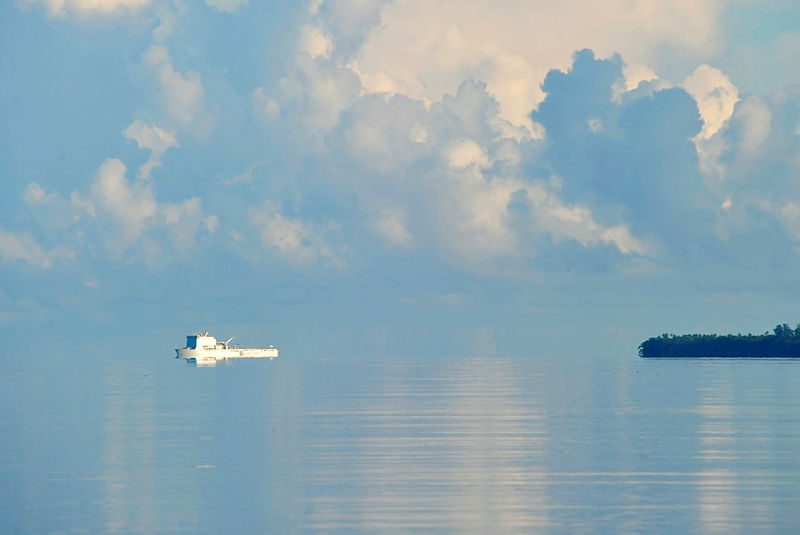
Commentary on equipping the Australian Defence Force tends to focus on high-end combat capabilities such as frigates, fighter aircraft and armoured vehicles. Much less is written about the assets and infrastructure that support those capabilities. When the supporting infrastructure is mentioned, it’s often from the point of view of parochial interests, such as the ongoing debate about whether the full-cycle dockings of Collins-class submarines should be conducted in South Australia or Western Australia.
In 2018, the US and Australian governments announced that that they would work with Papua New Guinea to redevelop the naval base on Manus Island to support Royal Australian Navy, US Navy and PNG Defence Force operations. However, little has emerged since then on what is being contemplated.
Manus Island has an excellent natural harbour and is strategically well located to provide forward support for RAN ships operating in the western Pacific, including the South China Sea. As a forward operating base, its weaknesses are that fixed infrastructure on Manus would be more vulnerable than fixed infrastructure at home bases and that access could be withheld if PNG assessed it was in its national interest to avoid being drawn into a conflict.
Both these weaknesses could be mitigated if all or most of the support the base provides was aboard a ship and mobile, rather than on land and fixed. A purpose-designed ship could provide fuel, storage and treatment for oily and brown-water discharge, stores and provisions, munitions, workshops and medical facilities. Ships and submarines would berth alongside such a vessel.
In the event of a direct threat to Manus Island, the ship could be relocated to other protected waters in PNG. If the PNG government no longer welcomed RAN ships, the support ship could relocate to another Pacific nation or to north Queensland, Broome or Darwin.
A large fleet support ship wouldn’t necessarily be expensive to buy or to run. It could be built to commercial standards and operated by a core civilian crew, similar to current navy support ships Sycamore, Besant and Stoker. RAN personnel and contractors could be embarked as ‘special personnel’, not crew, on a fly-in, fly-out basis. As a government-owned commercial vessel, it would fall outside the naval shipbuilding plan and could be built offshore like the new Australian Antarctic supply and research vessel, RSV Nuyina, which, despite being delayed, is nearing completion in Romania.
While such a ship could support destroyers, frigates and small vessels, it could be designed primarily to support the Attack-class submarines.
A support ship could enable these conventionally powered submarines to conduct back-to-back patrols without returning to home bases. It would have specialised berthing facilities, battery-charging capabilities, battery and mast workshops, an air supply for submarine escape systems, and the ability to embark and support Australia’s submarine rescue system.
Considering that Australia is in the process of doubling the size of its submarine force from six to 12 boats, it seems likely that, eventually, submarines will be based on both the east and west coasts. In October 2018, Marcus Hellyer published an ASPI paper titled Thinking through submarine transition. In it he said that:
the most important measure to grow the uniformed workforce will be to establish an east coast submarine base to provide access to Australia’s largest population centres. Without this, it’s very difficult to see how the Navy could ever crew the future submarine fleet, rendering the massive investment in the vessels nugatory. There are no clear, stand-out options for an east coast base, and all viable locations are currently occupied.
The 12 Attack-class submarines are but the first cycle of a rolling acquisition program for submarines, and a future government might decide on nuclear power for the next cycle. Nuclear-powered vessels are currently not authorised to enter Sydney Harbour.
A submarine support ship could be located in Sydney at least until the long-term composition and disposition of the submarine force is clear. Once the future is clearer, the support ship could be relocated elsewhere on the east coast or deployed to Manus Island.
A submarine support ship would perform its role in port or anchored in sheltered waters, so performance at sea wouldn’t drive its design characteristics. Because it would rarely be at sea, the ship would be less vulnerable to attack than fixed infrastructure since it could be relocated from an emerging threat location to a lower risk operating position.
In The Strategist last year, federal Labor MP Luke Gosling wrote that ‘Darwin should be a forward operating base for Australia’s submarines’. But Darwin isn’t suitable for that role because it is too far from deep water. Although large submarines can operate in water as shallow as 40 metres, that’s only after they have submerged and their trim has been balanced. When a submarine has refuelled, or replenished its stores or weapons, a theoretical trim is calculated and applied in port. For their initial dive after leaving port, large submarines require a minimum depth of about 100 metres to allow for variation between estimated and actual trim.
The distance from Darwin to water 100 metres deep is approximately 250 nautical miles. A submarine departing Darwin would need to transit on the surface for more than 24 hours before diving, which would leave it vulnerable to attack by mines, torpedoes, missiles or aircraft.
Darwin and Broome are roughly equidistant from the South China Sea. Broome might be suitable as a forward base as it’s about 84 nautical miles from water 100 metres deep, but the West Australian town has limited port facilities and, like Manus Island, would require a support ship.

